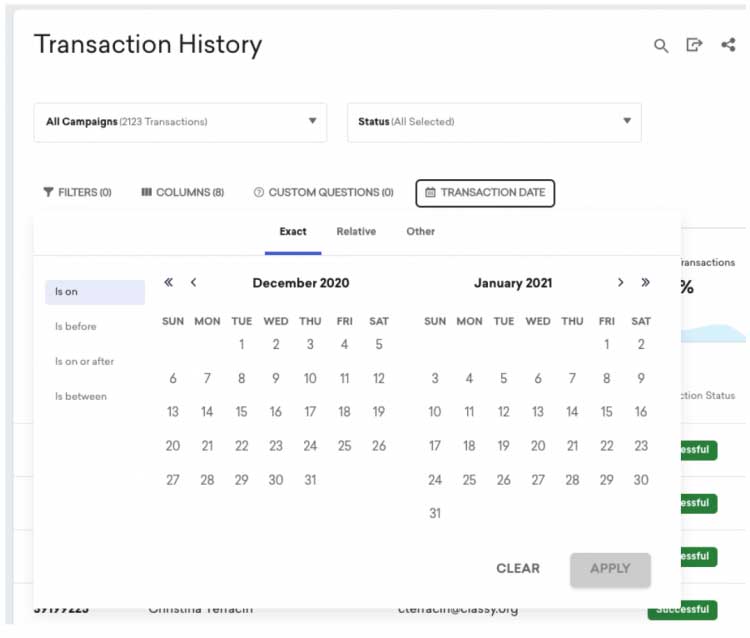5 Year-End Fundraising Metrics to Share with Your Board

Request a Demo
Learn how top nonprofits use Classy to power their fundraising.
This is a guest post by Audrey Phillips, Manager, Scaled Customer Engagement at Classy.
Now that the year has ended, organizations typically shift their focus to donor stewardship and fundraising plans for the new year. However, a critical step is often overlooked during this period: sharing fundraising metrics with your board.
It’s crucial to share your progress and keep your board updated so that they can fully understand the outcome of all of your year-end fundraising efforts. Boards help make important decisions with your team, so ensuring they are fully briefed on your results can help shape your fundraising strategy moving forward.
There are a million different data points you could pull to share with your board. While it’s great to give them detailed information, it’s also important to highlight the most essential metrics to help summarize your year-end giving efforts. Here are the top five metrics to share and why they matter.
1. Total Amount Raised for Year-End Campaign(s)
Convey the total fundraising progress you made with your year-end fundraising efforts to your board immediately. This is the first data point they’ll be looking for, and thankfully, it’s easy to pull from Classy.
Within your transactions report, you can filter by a date range to show any gifts made during your year-end appeal time. If you enter your offline checks, these will also appear.

A few things to look out for:
- Are you still receiving many checks?
- Do those checks typically come in solely during year-end?
- Is there any opportunity to convert those donors to online giving?
You can also filter by dates for previous year-end appeals in order to make year-over-year comparisons. Ideally, you’ll want to see if your year-end giving is growing each year. If you find that your fundraising is decreasing, it’s time for your team to evaluate why this might be occurring. It could be related to something out of your control (like a pandemic), but that doesn’t mean there aren’t strategies you can implement to help boost your support the following year.
Oftentimes, more frequent communication with your supporters results in more donations. Create a robust year-end email and social media plan to ensure you have enough touchpoints with your community. Resources like our 9 email templates for your annual communication can help you make sure you’re reaching out effectively throughout the year.
Download Now: 9 Email Templates for Your Annual Communication
Additionally, start thinking ahead toward donor stewardship to ensure your existing supporters feel valued and understand their impact so that you can ensure they become repeat donors.
2. Total Number of Gifts Received for Year-End Campaign
While the total amount raised for your year-end campaign is your star metric, the total number of donations you received helps paint a more detailed picture of your year-end giving.
You’ll want to see how many transactions were actually made. This can also be found in your Classy transactions report after filtering by a date range and/or campaign. While your overall goal is likely to increase the amount raised, it’s also important to increase the number of gifts made, thus growing the number of donors to your year-end campaign. If you have more people supporting you, you have a greater opportunity to build more relationships and steward these supporters to become major donors.
Additionally, your supporter management tools can help you identify the top donors who deserve some extra love through a phone call or handwritten thank you card. In your transactions report, you can sort by transaction size to see who donated the most. You can also sort by name or email to see if you had any repeat donors and by gift frequency to see if it was a recurring gift. Any of these donors can also be considered VIP supporters. An easy way in Classy to message all donors within a campaign is to create a Campaign Message within your emails, and provide an update with what you were able to accomplish this year-end thanks to their support, along with another thank you.
3. Average and Median Gift Sizes
In a similar vein, it’s important to know the majority of your donors’ giving levels so this can inform your campaigns and donation pages. Classy will calculate your average gift size automatically in your transaction report. We suggest adding a filter to exclude offline gifts so you have a true average of online donations that is not skewed by larger checks.
We also recommend pulling your median gift size to ensure that outlier numbers don’t skew your results. You can use the average and median online donation values to shape your suggested donation amounts in the future. For example, if most people donate around $100, you might use $100 as one of your middle-range donation button amounts, with a slightly higher amount as the suggested donation to promote people donating at a higher level.
Read Next: How to A/B Test Donation Pages to Drive Recurring Gifts
4. Number of New Donors Acquired
Your organization should always be striving to bring in new donors so that you can build your support and avoid donor fatigue with your existing base. Acquiring new donors is no small feat, and while they may come in as small donors, there’s always the potential to steward your relationships and convert them into repeat, loyal donors.
Make sure to send new donors an email welcome series so that they can learn more about your organization. This will help you make a great first impression and start building those relationships, so these supporters will eventually donate again.
To cover the other end of the spectrum, you can also pull a report of supporters and sort it to see the dates of their most recent gifts. For anyone who hasn’t donated in the last year, create a separate outreach strategy to reintroduce your programs and the impact each gift has on them, hoping to convert them from lapsed donors into current supporters.
Download Now: A Guide to Nonprofit Welcome Emails
5. Percent of New Recurring Donors
Make sure to share the percentage of new recurring donors you acquired this year-end. Recurring donors are your most loyal, passionate donors, and they’re more likely to make additional gifts throughout the year on top of their regular support. According to The State of Modern Philanthropy 2020, of recurring donors who signed up through a donation page and took additional action on the Classy platform, 11% made a contribution to a crowdfunding campaign, 16% purchased an event ticket, 14% signed up to fundraise or donated to a registration with fundraising campaign, and 10% participated in a peer-to-peer campaign.
Creating a full fundraising strategy around obtaining new recurring donors and asking existing recurring donors to increase their monthly contributions is a must for all nonprofits as you aim to boost your fundraising revenue and impact.
Download Now: 8 Free Email Templates to Upgrade Your Recurring Donors
Bonus Metrics
If you want to share more detailed metrics, you can also highlight the percentage of donors who chose to add an additional amount to their donation to help cover a portion of the fees. We call this Classy Mode. Your board is oftentimes involved in discussions around your budget. If you can show that your software costs are offset by donors giving more, they will be more open to investing in critical tools for your organization.
Also, consider sharing any data about peer-to-peer fundraisers, such as the number of fundraisers who started personal fundraising pages on your behalf, the total amount raised by fundraisers, and the average amount raised by fundraisers.
Other Fundraising Strategies to Consider
As you pull and sort through your reports, if you find that you have a solid foundation of one-time donors, start thinking about further strategies that could increase their engagement. Recurring giving programs are an excellent way to allow donors to get more involved with your organization and make a monthly commitment to your cause. It also can fit more supporters’ budgets since the ask is to make a smaller monthly gift rather than a one-time large donation. At Classy, we often see our customers find great success using a crowdfunding platform and highlight details around monthly giving on their landing page.
You also can harness the energy of supporters by using a peer-to-peer fundraising platform. When your supporters can create their own personal fundraising pages on your behalf, you open yourself up to new donors as your fundraisers share their own personal stories with your cause and mission and solicit their networks for donations. Some organizations will choose to do a peer-to-peer campaign that runs for a specific amount of time (typically 6 to 8 weeks), and others will create a DIY peer-to-peer campaign where supporters can always utilize the page to fundraise for special events throughout the year, like their birthdays.
While there are many different ways to pull this data, the great news is that Classy makes it super easy to manage your supporters and pull the metrics you need. Within Classy Manager, each menu tab (Campaigns, Transactions, Supporters, Fundraisers) is actually a different report. You can also add filters to create a more narrow view and additional columns to add any extra information. Classy will also allow you to save reports so that you don’t have to build them from scratch each time you log in. Additionally, you can export data to Excel and share links with other Classy administrators on your team. Check out our support article and video tutorial on how to create custom reports.
Remember, allow data to provide a summary of your year-end fundraising efforts and set the building blocks for your fundraising strategies in the next year.

The Quick Start Guide to Data-Driven Fundraising
Subscribe to the Classy Blog
Get the latest fundraising tips, trends, and ideas in your inbox.
Thank you for subscribing
You signed up for emails from Classy
Request a Demo
Learn how top nonprofits use Classy to power their fundraising.
 Explore Classy.org
Explore Classy.org 

